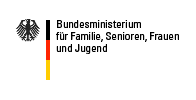Aspects
Aspects home affairs policy
- E-government: Within the framework of modernisation of the administration, e-government [German] has been introduced with the aim of making the work of the federal government more accessible via the Internet. From the gender perspective, this raises the question as to whether all target groups of the federal government have the same conditions for access to the Internet or whether it is such a matter of course for certain groups of the population (e.g. senior citizens and unemployed persons) to use or feel at ease with modern information technology (IT). A second question is raised, namely relating to the gender-typical division of labour, which is possibly reproduced and consolidated by the introduction of IT jobs. Are women and men allocated to different jobs?
Modernisation of administration possible also means that case work employment is cut in favour of employment in the IT sector. What does this mean for the employment situation of women and of men?
- Staff: Employment conditions in the civil service possibly include indirect or direct disadvantages for certain groups of staff. Direct disadvantages can occur by virtue of staff selection and evaluation, arising through the use of inappropriate or stereotypical criteria. Indirect disadvantages can occur if, for instance, working conditions do not permit reconciliation of work and family. Professional staff development counters such disadvantages. The basis for this is delivered by data that are differentiated in terms of gender on the employment structure in the civil service.
- Security: Creating internal security means combating criminality and extremism. It is important here to pursue the causes of crime and see them as approaches for prevention. Statistics show that both perpetrators and victims of crime are more frequently men than women and more frequently young men than older men. How can this greater propensity for violence in men be explained and what is the role in this of the traditional concept of masculinity? What does social rule-breaking by women look like?
- Police: The police is an important actor in the creation of internal security. How is cooperation between women and men shaped here? How must the police act in public to guarantee security equally for all population groups?
- Border security: Within the framework of its police work, the Federal Border Police (BGS) secures Germany’s external borders, above all to prevent unauthorised immigration by foreigners in order to combat cross-border people-smuggling and forgery of documents. This involves concrete situations where BGS officers have to deal with refugees, especially at the external borders of the Schengen member states and at international airports.
Even after the Schengen Implementation Convention came into force, the BGS maintains its presence at the internal borders between Schengen member states in order to counter the shifting forms of cross-border crime, including organised crime.
Gender Mainstreaming can make a contribution to making officers aware of gender-specific discrepancies in dealing with refugees. Because of the various different reasons for flight and the situations people are escaping from, depending on gender and other social differentiation factors (e.g. ethnic origin), different female and male refugees have varying motives for flight. An awareness of these various life situations can make dealing with refugees easier for officers. It can be important for the way the BGS is regarded as a democratic institution to communicate this image of the BGS in public.
Combating people smuggling and human trafficking is one of the main focuses of border security. Men and women are often differently affected here. People smuggling is “assisting flight” for money, which not infrequently takes on some of the forms of human trafficking. For women in particular, it often means being forced into prostitution in the destination country. Officers should be prepared by awareness training for recognising victims of people trafficking when dealing with female refugees, even though they may not at first sight fit the image of a victim.
Further reading:
On violence against women:
Federal Ministry for Family Affairs, Senior Citizens, Women and Youth (BMFSFJ): Working together to combat domestic violence: Cooperation, intervention, research. Findings of the evaluation research assessing intervention projects against domestic violence (German acronym: WiBIG) (2004),
Federal Ministry for Family Affairs, Senior Citizens, Women and Youth (BMFSFJ): Second Action Plan of the Federal Government to Combat Violence against Women (2007),
Federal Ministry for Family Affairs, Senior Citizens, Women and Youth (BMFSFJ): Health, Well-Being and Personal Safety of Women in Germany. A Representative Study of Violence against Women in Germany - Summary of the central research results (2004),
On violence against men:
Federal Ministry for Family Affairs, Senior Citizens, Women and Youth (BMFSFJ): Violence against men. Men’s experiences of interpersonal violence in Germany – Results of the pilot study (2004),
Bundesministerium für Familie, Senioren, Frauen und Jugend: 1. Datenreport zur Gleichstellung von Frauen und Männern in der Bundesrepublik Deutschland – Kapitel 10: Gewalthandlungen und Gewaltbetroffenheit von Frauen und Männern, erstellt vom Deutschen Jugendinstitut in Kooperation mit dem Statistischen Bundesamt, Berlin 2005.
Federal Ministry for Family Affairs, Senior Citizens, Women and Youth (BMFSFJ): Working together to combat domestic violence: Cooperation, intervention, research. Findings of the evaluation research assessing intervention projects against domestic violence (German acronym: WiBIG) (2004),
Federal Ministry for Family Affairs, Senior Citizens, Women and Youth (BMFSFJ): Second Action Plan of the Federal Government to Combat Violence against Women (2007),
Federal Ministry for Family Affairs, Senior Citizens, Women and Youth (BMFSFJ): Health, Well-Being and Personal Safety of Women in Germany. A Representative Study of Violence against Women in Germany - Summary of the central research results (2004),
On violence against men:
Federal Ministry for Family Affairs, Senior Citizens, Women and Youth (BMFSFJ): Violence against men. Men’s experiences of interpersonal violence in Germany – Results of the pilot study (2004),
Bundesministerium für Familie, Senioren, Frauen und Jugend: 1. Datenreport zur Gleichstellung von Frauen und Männern in der Bundesrepublik Deutschland – Kapitel 10: Gewalthandlungen und Gewaltbetroffenheit von Frauen und Männern, erstellt vom Deutschen Jugendinstitut in Kooperation mit dem Statistischen Bundesamt, Berlin 2005.
erstellt von Administrator
—
zuletzt verändert:
02.01.2010 20:08





